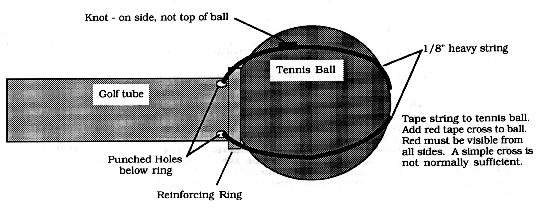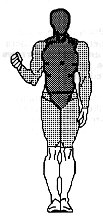
Bow Types: Recurve, take-down (where the limbs are detachable) and long bows are allowed but compound bows are prohibited. Crossbows are permitted providing they are capable of dellvering comparable force between the 30 pound and 50 pound limits (600 and 1,000 inch-pounds, see measurement in INSPECTION section). All crossbows must utilize bolts made in the same method as arrows but cut appropriately to match the crossbow such that just the tennis ball extends beyond the prod (the part that looks like a bow on a crossbow).
NOTE: Some localities consider crossbows to be equivalent to fire-arms. Be sure to check local ordinances before allowing crossbows in combat archery at your event.
Arrows: Combat arrows shall be constructed by using a plastic golf tube and attaching a tennis ball to the reinforcing ring end with tape and heavy cord
[A golf tube is a round tube made of plastic that is designed in its mundane life to be put into a golf bag to separate the golf clubs from each other]
The ball must be attached with strong cord, less than or equal to 1/8" in diameter. Tape alone is not considered sufficient. Knots and other large masses of cord are not permitted on the tip of the arrow. The cord must be securely attached to the tennis ball with tape or other equivalent means, such that the ball cannot slip out from under the cord.
The ball must be covered with a cross of red or international orange tape. The entire surface area of the tennis ball need not be covered as long as there is sufficient red showing from all angles that the arrow would normally be held.
(Archers should note that hand darts are similar to combat arrows, but the tennis ball is black with a silver cross. Hand darts are not to be fired from any bow.)

Fletchings must be of soft, flexible material such as foam or duct tape and rounded so as to present no sharp corners. Fletchings are not required and the size and number of fletchings are left to the discretion of the archer provided no fletching can protrude more than 0.5" inch into a legal helm.
The length of each arrow shall be no more than 28" from the bottom of the nock to the base of the tennis ball. (this will probably require trimming down a commercial golf tube)

Arrow shafts may be covered with tape but need not be. No additional weight beyond that needed to construct the arrow is allowed. No part of the arrow except the ball may be taped with red tape or otherwise colored red. A notch may be placed at the trailing end of the arrow if desired. The size and depth of this notch are left to the discretion of the archer. Notches may be reinforced to help maintain the shape. Holding tabs constructed of cloth or light leather are allowed on the end of arrow to aide in being held by archers wearing gauntlets.
All arrows require an identifiable and visible "owner's mark". This marking may be any standard cresting that is registered with the Marshal-in-Charge, but a written name and kingdom is preferred. Any arrow not marked such that the owner can be readily identifled shall be banned from the field. Unmarked arrows found on the fleld shall be confiscated and not returned. As crested arrows would require leaving the fleld to identify the owner, this method of identification is not recommended.
Non-standard missile weapons (slings, tennis ball crossbows, etc.) must be approved for use by the Marshal-in-Charge with a report forwarded in writing to the Earl Marshal for final approval.
All weapons that use a charge of burning or explosive gases, or compressed gasses are explicitly prohibited.
Archers may not wear or carry shields on their arms while shooting a bow.
Pavises: Archers may use a pavis, a legal unmanned shield propped up by a legal Javelin or piece of rattan that is beveled at both ends so that it presents no danger to the fighters if it should be detached from the pavis. Quivers attached to pavises are acceptable. Free standing arrow quivers are not acceptable due to the hazard they present to someone falling or tripping over them.
Archers may not use or hold (in their hand) a rattan weapon while holding a bow. They may, however, carry a rattan weapon as a backup weapon as long as it is secured while they are wielding the bow. An archer may drop his bow (to the ground or handed to another; it may not be "slung" in any manner) and draw a rattan weapon, being then considered a standard heavy weapons flghter. The rattan weapon must have a metal basket hilt to protect the fingers of the bow hand while in use. If the archer later picks the bow back up, the rattan weapon must be dropped or re-secured. Any archer caught wielding both a bow and hand weapon shall be considered killed. As in all war scenarios, secondary weapons do not require a lanyard or safety strap.
Archers are responsible for where their arrows land and are responsible for the conditions of the arrows that they shoot, including those gleaned from the field during combat. Non-archers may carry arrows and scouts may glean and carry arrows for archers. Archers that have been killed may choose to leave their bow on the field for others to use but may not then be selective about who may use the weapon. Due to the decreased risk of defective arrows, archers may field inspect and re-fire arrows gleaned from the field.
Archers may not carry a shield on their arms while using a bow. If the bow is dropped, the fighter may arm with a weapon and shield but both the shield and weapon must be removed before taking up the bow again. A "slung" shield counts as armor (i.e. does not block blows).
Arrows must hit point first to count but need not hit with equivalent force to a heavy weapons blow to count. Arrows that glance off a target may kill those standing behind or adjacent to the target provided they have maintained most of their initial force. Arrows striking the ground shall be considered dead, even if they bounce up and strike a fighter. Legal targets with arrows are the same as for heavy weapons spears (see diagram). Arrows may not be thrown by hand nor may they be used as thrusting weapons. At their option, archers are allowed to use a combat arrow to kill from behind (per those rules) as a safety consideration.
Archers attacking other fighters: All combatants (including other archers and javelineers) are considered to be engaged with any archer that can potentially hit them once combat commences. It is legal for archers to attack the back of fighters within range but they should preferentially engage fighters facing them.
Archers beine attacked by non-archers: Fighters may not grasp, strike or swing at a bow or arrow to disrupt an archer from shooting. Fighters may strike any archer that has been properly engaged and has not yielded. Archers are 'killed from behind' in the same manner as any other heavy weapons fighter (provided the scenario rules allow killing from behind). An archer that is engaged by a fighter and turns his back does not negate a blow that was already started and strikes him in the back. Fighters may not strike any archer that yells 'YIELD', signifying that he is to be considered dead. Archers that have yielded should kneel, place their bow on the ground, and shout "yield" (repeatedly if necessary). Yielded archers should attempt to leave the field as soon as possible and at that time hold their bows over their heads while leaving the combat field. Fighters may not demand that an archer yield but may offer the archer the opportunity. Any fighter that strikes an archer that has yielded and is on his knees with his bow on the ground, or an archer that has died and is holding his bow over his head, is subject to an immediate Marshal's Court. Fighters may not intentionally damage combat missiles (arrows and javelins) in order to remove them from the field of combat.
An archer may not attempt to block a rattan weapon with a bow or arrows. Bows that are struck with a rattan weapon shall be considered broken and may not be used again until they are reinspected off the field for damage. Bows and arrows given to marshals or constables are considered removed from the field. A quiver of arrows is not considered armor and will not have any effect on the blows of rattan weapons or arrows. The arrows in a quiver that is struck are not considered to have broken.
Blockine Arrows: Arrows may be blocked by shields, rattan weapons, javelins, bows and other arrows (if in flight). An arrow may be blocked by a bow, but if the arrow strikes the bow squarely (rather than being knocked aside) the bow is considered destroyed. A bow may be used to attempt to sweep arrows aside without damage to the bow. If a fighter is struck on either hand while attempting to block an arrow in flight, the hand is considered injured and unusable. Turning your back to an arrow in night does not negate its effects.
 Killing zones for all arrows, hand darts, and javelins shall be the head, torso, abdomen, groin and from inside the crown of the shoulder inwards toward the neck. Blows to the arms, shoulders, hips and legs shall be considered to have incapacitated the appropriate limb. Strikes to the baclr a target are considered good. An archer is considered to be engaged with all targets within range.
Killing zones for all arrows, hand darts, and javelins shall be the head, torso, abdomen, groin and from inside the crown of the shoulder inwards toward the neck. Blows to the arms, shoulders, hips and legs shall be considered to have incapacitated the appropriate limb. Strikes to the baclr a target are considered good. An archer is considered to be engaged with all targets within range.
| Caid Combat Handbook - Volume II | 8/30/95 |